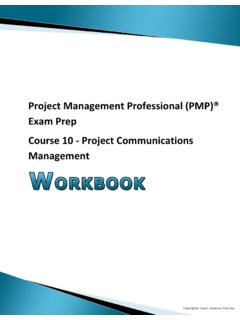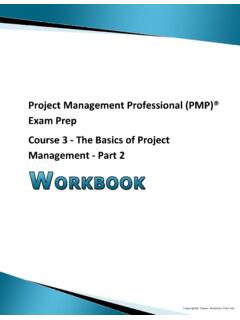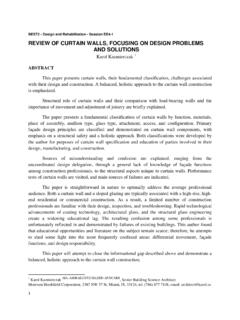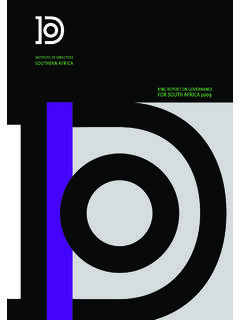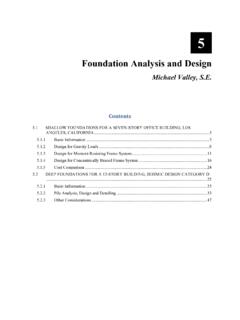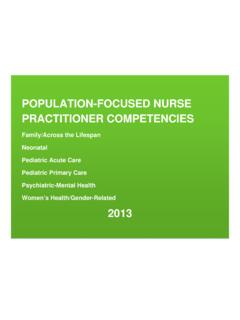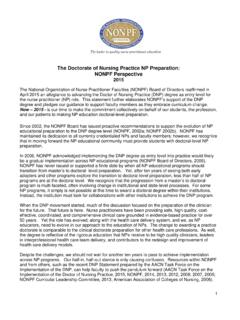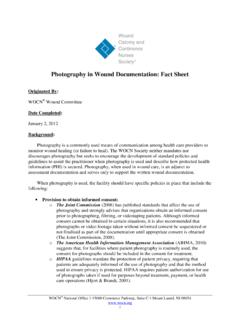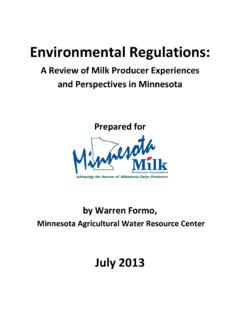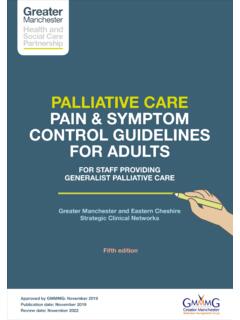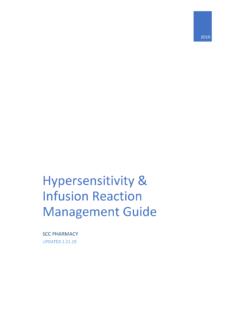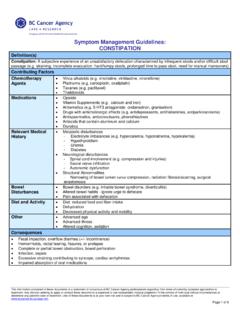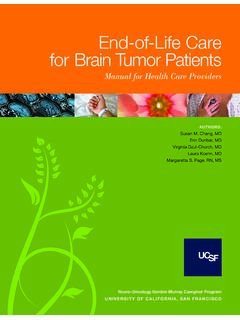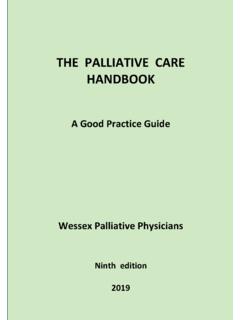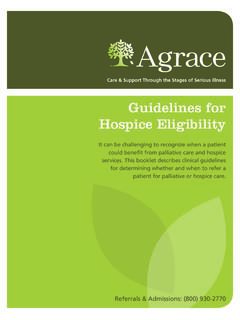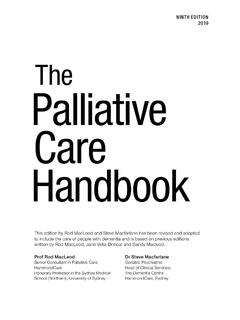Transcription of Hospice Clinical Documentation
1 AHPCO Spring Conference05/23 Clinical DocumentationProving Hospice Regulatory ComplianceBy Beth Noyce, RN, BSJMC, HCS-D COS-CCopyright 2014 Hospice Clinical Documentation Course Objectives: Successful course participants will learn to: Recognize common Documentation errors. Discuss the implications of erroneous, inadequate or untimely Documentation . Identify methods for improving Clinical Documentation Hospice benefit available to beneficiaries who: Are entitled to Part-A Medicare benefits; Are certified as terminally ill; Elect the Hospice benefit; Knowingly waive other certain Medicare Spring Conference05/23 Clinical Compliance Hospice providers are eligible for claim payment if the patient record shows: Beneficiary is eligible for Hospice services; Services provided were medically necessary; Hospice provider met all regulatory requirements. Hospice COVERAGEH ospice Coverage Technical requirements for Hospice coverage: Notice of Election (NOE) Prior to Hospice admission: Certification of Terminal Illness (CTI) Required for each benefit period: Face-to-Face Encounter Documentation Required for each third and later benefit period.
2 AHPCO Spring Conference05/23 Coverage Clinical Documentation requirement for Hospice coverage: Patient record must support Documentation in technical elements. Terminal prognosis of 6 months or less LCD criteria Days in any billing period without corresponding Documentation showing eligibility are unpaid. IDG, CARE PLAN, SERVICE COORDINATIONIDG, Care Plan, Service Coordination Approach to Service Delivery IDG provides Hospice care/services Based on Hospice patient/family needs Physical Medical Psychosocial Emotional SpiritualAHPCO Spring Conference05/23 , Care Plan, Service Coordination Plan of Care All IDG members contribute Doctor of medicine or osteopathy Registered Nurse Social worker Pastoral or other counselor Involve any attending physicianPlanIDG, Care Plan, Service Coordination Plan of Care Based on assessment assessments Initial, comprehensive, and updated Individualized Specifies care and services needed To meet patient and family-specific needs related to the terminal illness and related , Care Plan, Service Coordination Needs unrelated to terminal illness Hospices not required to provide these services; Must acknowledge, document who is addressing; Medicare considers most conditions as contributing to terminal illness.
3 Hospice physicianmust document why any condition is not Spring Conference05/23 , Care Plan, Service Coordination Hospices must provide virtually all care of terminally ill patients: Most problems are related to the terminal illness. All needed services are considered related . IDG, Care Plan, Service Coordination Care Plan Content Pain and symptom management interventions; Scope and frequency of needed services; Measurable outcomes anticipated; Drugs and treatment needed; Medical supplies and appliances needed;IDG, Care Plan, Service Coordination IDG must document patient s/representative s: Level of understanding the care plan, Involvement in the care plan, Agreement with the care plan, In accordance with the Hospice 's own Spring Conference05/23 , Care Plan, Service Coordination IDG: review, revise, document care plan: Involving any attending physician; As frequently as patient condition requires; At least every 15 , Care Plan, Service Coordination Revised Care Plan must include: Updated comprehensive assessment information; Progress toward care plan outcomes and goals; Documentation that assessment revealed no needed changes, if no changes are required.
4 IDG, Care Plan, Service Coordination Documentation must show that Hospice care and services: Are directed, coordinated, and supervised by the IDG; Follow the plan of care; Are based on patient and family need assessments;AHPCO Spring Conference05/23 , Care Plan, Service Coordination Service coordination Documentation : Shows information sharing Between all disciplines In all settings Provided directly Provided under arrangement With any non- Hospice providers furnishing services unrelated to the terminal illness and related Hospice coding matters Hospice update final rule published 08/07/13 Clarified Hospice diagnosis reporting Complete, comprehensive coding required; Must follow official coding guidelines; Targeted non-specific and manifestation codes used Hospice coding matters Hospice update final rule published 08/07/13 Incorrectly used diagnoses as terminal illness 2002 < 10% of Hospice claims 2012 > 25% of Hospice claims Using less-specific, or catch-all codes Has become more common among Hospice providers; In spite of prior clarifications to follow coding guidelines; Has been allowed without Spring Conference05/23 Hospice coding matters Hospice update final rule published 08/07/13 Clarified that hospices must report: Terminal illness diagnosis; All coexisting or additional diagnoses related to the terminal illness and related conditions.
5 Data needed to evaluate Hospice payment reform Hospice coding matters HIPAA requires choosing the most correct, specific diagnosis codes. Medical record Documentation must consistently support the the ICD-9-CM diagnoses documented in the Hospice coding matters Diagnosis- related CTI Content: Patient s name and terminal diagnosis; Prognosis: life expectancy is 6 months or less if the terminal illness runs its normal course; The physician s brief narrative explanation of the Clinical findings that supports a life expectancy of 6 months or less; Includes co-morbidities and their contribution to patient Spring Conference05/23 ICD-9 DIAGNOSESS upport ICD-9 diagnoses Final Rule 8/7/2013: Terminal illness: Advanced, progressively deteriorating illness Diagnosed as incurable. Support ICD-9 diagnoses Terminal illness/primary diagnosis is: Identified by certifying Hospice physician(s) as: Chiefly responsible for the services provided; AND Most contributory to the terminal Spring Conference05/23 ICD-9 diagnoses CMS: We believe that the certifying physicians have the best Clinical experience, competence and judgment to make the determination that an individual is terminally ill.
6 Clinical Documentation must support life expectancy of 6 months if the physician-identified terminal illness runs its normal ICD-9 diagnoses Cancer diagnoses Amyotrophic Lateral Sclerosis Heart Disease HIV Disease Liver Disease Pulmonary Disease Chronic Renal Failure Stroke ComaSupport ICD-9 diagnoses ICD-9 diagnosis codes selected must match the primary diagnosis/terminal illness the physician identifies. A change in terminal illness requires Documentation by the physician and a change on the next CTI, but no new mid-benefit period CTI. AHPCO Spring Conference05/23 ICD-9 DIAGNOSESN ever-primary ICD-9 diagnoses HIPAA: Hospice must follow coding rules. Assign the most specific diagnosis code available. Code sign and symptom codes only when no related , definitive diagnosis has been confirmed. Manifestation codes are not allowed as ICD-10 diagnoses CMS: Does not require the physician to determine the actual codes for the diagnosis. Expects hospices to determine to the actual codes associated with diagnoses cited by physicians.
7 Hospice must press physicians for needed Spring Conference05/23 ICD-10 diagnoses Debility & Adult Failure to Thrive : Not allowed as primary, as of Oct 1, 2014 : Considered questionable for Hospice ; Returned to the provider for more definitive principal diagnosis OK as contributing ICD-10 diagnoses CMS: Don t list etiology dementia diagnoses as principal diagnosis. Don t split ICD-9 etiology/manifestation pair Example: Alzheimer s Dementia Alzheimer s Disease Dementia in conditions classified elsewhereRELATED ICD-9 DIAGNOSIS CODESL esson 5 AHPCO Spring Conference05/23 ICD-9 diagnosis codes The Hospice claim must include: All diagnoses related to the terminal illness/principal diagnosis. All comorbid conditions that contribute to the prognosis of 6 months or less. Medicare: THIS IS NOT A NEW RULE! related ICD-9 diagnosis codes In January-March 2013: 72% of Hospice providers listed only 1 diagnosis; Coexisting diagnoses help describe Hospice patients Hospice data is incomplete without comorbidities.
8 Incomplete data could negatively impact future Hospice reimbursement. related ICD-9 diagnosis codes Hospice providers must pay for all care: related to the terminal illness; related to coexisting or contributing conditions; Caused by the treatment of Spring Conference05/23 ICD-9 diagnosis codes Hospices must provide virtually all care of terminally ill patients: Most problems are related to the terminal illness All needed services are considered related Exceptions: Require documented, clear evidence that a condition is unrelated; Hospice physician must document why Hospice patient needs are unrelated to terminal illness. Hospice LCD S & ICD-9 DIAGNOSESH ospice LCD s & ICD-9 diagnoses MAC Hospice LCD: Help providers determine Hospice eligibility; Guide MACs in reviewing claims; Apply to all Hospice Spring Conference05/23 LCD s & ICD-9 diagnoses Beneficiaries qualify for Hospice if they meet: Non-disease specific decline guidelines in part 1OR Guidelines in both Baselinenon-disease specific guidelines in part 2+ The applicable, disease-specific lists in the appendixHospice LCD s & ICD-9 diagnoses Part 1 - Clinical status decline guidelines: Decline presumes change over time; Requires baseline and follow-up assessments; Establish baseline on admission or from Clinical record; Variables other than those listed may also support 6-month life expectancy, and should be LCD s & ICD-9 diagnoses Part 1 - Clinical status decline guidelines: Apply to patients whose decline is not reversible.
9 Listed in order of their likelihood to predict poor survival: Most predictive first. Least predictive last. No specific number of variables must be met; Longevity prediction of 6 months or less requires: Fewer of those listed first (more predictive); More of those listed last (least predictive). AHPCO Spring Conference05/23 LCD s & ICD-9 diagnoses Disease progression, as worsening: Clinical status Recurrent, intractable infections Progressive inanition, documented as decreasing: Weight and/or anthropomorphic measurements, not due to reversible causes such as depression or diuretics serum albumin or cholesterol Dysphagia leading to: Recurrent aspiration Inadequate oral intakeHospice LCD s & ICD-9 diagnoses Disease progression, as worsening: Symptoms Dyspnea with increasing respiratory rate Cough, intractable Nausea/vomiting poorly responsive to treatment Diarrhea, intractable Pain requiring increasing doses of major analgesics more than LCD s & ICD-9 diagnoses Disease progression, as worsening.
10 Signs Systolic BP decline to < 90, or progressive postural hypotension Ascites Venous, arterial or lymphatic obstruction due to local progression or metastatic disease Edema Pleural / pericardial effusion Weakness Change in level of consciousnessAHPCO Spring Conference05/23 LCD s & ICD-9 diagnoses Disease progression, as worsening: Laboratory results (If available): Increasing pCO2 or decreasing pO2 or decreasing SaO2 Increasing calcium, creatinine or liver-function studies Increasing tumor markers ( CEA, PSA) Progressively decreasing or increasing serum sodium or increasing serum LCD s & ICD-9 diagnoses KPS or PPS decline from <70% due to disease progression; Increasing ER visits, hospitalizations, or physician s visits related to Hospice primary diagnosis; Progressive decline in FAST for dementia From 7A on the FAST; Dependence on assistance with additional ADLs See Part II, Section 2; Stage 3-4 pressure ulcers in spite of optimal LCD s & ICD-9 diagnoses Part II.
